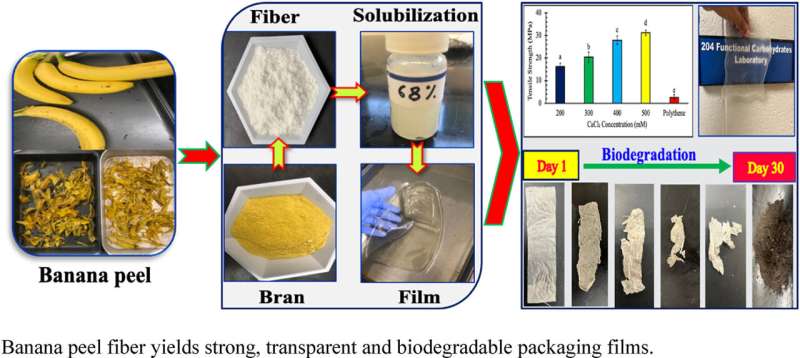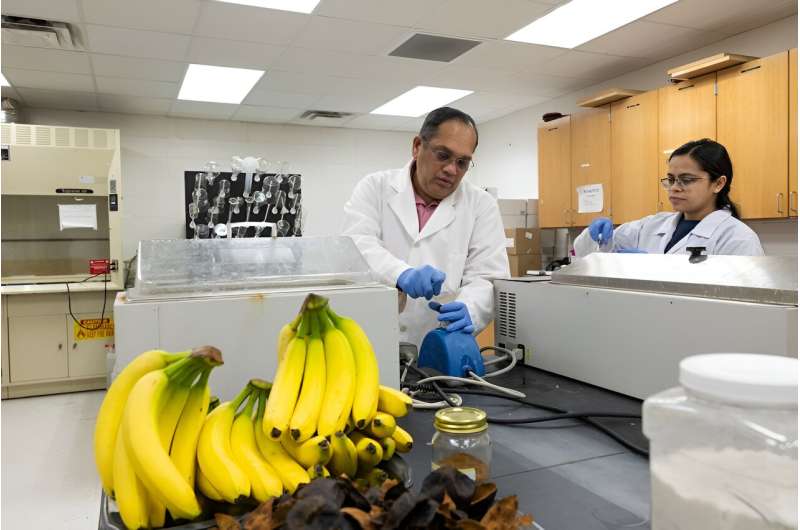This article has been reviewed according to Science X's editorial process and policies. Editors have highlighted the following attributes while ensuring the content's credibility:
fact-checked
trusted source
proofread
How bananas can be used to fight the plastic waste crisis

Bananas are one of the most popular and widely consumed fruits in the world. They are also the fourth most grown crop in the world, trailing only rice, wheat and corn. What could this tropical fruit have to do with fighting the ongoing plastic waste crisis?
A lot, potentially, according to Srinivas Janaswamy, associate professor of food chemistry in South Dakota State University's Department of Dairy and Food Science. His study, titled "Biodegradable packaging films from banana peel fiber" was published in the journal Sustainable Chemistry and Pharmacy.
"Many of us consume at least one banana a day," Janaswamy said. "After enjoying the delicious fruit, we discard the peel. What if we could find a use for the peel that helps eliminate plastic waste?"
For the past few years, Janaswamy has been researching how different agricultural byproducts, like banana and avocado peels, can be utilized to create biodegradable films—plastic-like packaging materials that will decompose in the environment. One of the biggest challenges with petroleum-based plastic—the most common type of plastic—is its lack of decomposition.
For example, plastic packaging, like plastic bags, will take up to 20 years to decompose. With very little plastic being recycled, most end up in landfills or littered in the greater environment, creating serious health and environmental consequences. Finding a plastic-like alternative that will decompose relatively quickly would go a long way in fighting the ongoing plastic waste crisis.
"Overall, the lack of biodegradability of plastics and its effects on human health and the environment warrant remediation measures with a viable alternative," Janaswamy said. "Banana peels stand out as a promising and inexpensive material."
Banana byproducts
Because bananas are one of the most widely grown fruits in the world, they create a tremendous amount of byproducts. Around the world, banana plantations produce about 220 tons of residue per 2.5 acres. Banana residue is made up of predominantly lignocellulosic material, the key ingredient to creating biodegradable films.
"Lignocellulosic residue from biowaste stands out as a viable alternative to make bioplastics due to its robust structure, biodegradability, low density and non-toxicity," Janaswamy noted.
Banana residue—the peel—nearly always goes unused, making it a near-perfect byproduct to utilize for this work.
"Every year, almost 36 million tons of banana peels are produced, most of which are disposed of as waste," Janaswamy said. "The food processing industry discards a huge amount of banana peel in landfills while manufacturing chips, flour, juice, jam, baby food and other products made from bananas. Finding a more practical use for banana peels is important for providing financial benefits to the agricultural industry and preventing environmental pollution."

On top of this, banana production has increased by 10% between 2010 and 2020 and is expected to continue to grow over the next decade. The need for plastic packaging material is also expected to grow as demand increases for packaged and processed foods.
In short, an environmentally friendly plastic-like packaging material is desperately needed. In a new study, Janaswamy and Mominul Hoque, a graduate research assistant at SDSU, demonstrated how banana peels can be utilized to create biodegradable films—something that may one day replace petroleum plastic as the dominant food packaging material.
From peel to 'plastic'
The research team first turned the used peels into a bran using a blender. Then, as Janaswamy and his team had done previously with avocado peels, spent coffee grounds and switchgrass, they extracted the lignocellulosic material using a chemical treatment process. The extracted fibers then underwent bleaching, distilling and treatment before being prepared into a film. After drying, the film's properties were tested.
"The films are strong and transparent, and more importantly, biodegrade within 30 days at 21% soil moisture content," Janaswamy said. "The finding opens up new possibilities for banana peel and other fruit processing byproducts in designing and developing plastic-replacing biodegradable packaging."
Transparency is one of the essential properties of films, as consumers prefer transparent packaging to judge a food's freshness. The prepared films in this study were more transparent than previous films made from different byproducts.
Values associated with tensile strength and elongation can be used to predict if a film can maintain its integrity as a food packaging material. As Janaswamy notes, the values associated with banana peel films are higher than commercial grocery sack bags.
"The films of the banana peel fibers display tensile strength of more than 30 MPa, which certainly would be attractive for sack bags and related packaging applications," Janaswamy explained.
Overall, the properties show that banana peels could be a viable material used to make biodegradable films.
"Our research involving green and recyclable chemicals is a promising economical and sustainable route to produce biodegradable films to replace petrochemical plastics and is thus an attractive contribution to the circular bioeconomy," Janaswamy added.
Further research will look to improve the film's flexibility and investigate the scalability and commercialization of this preparation process.
More information: Mominul Hoque et al, Biodegradable packaging films from banana peel fiber, Sustainable Chemistry and Pharmacy (2023). DOI: 10.1016/j.scp.2023.101400
Provided by South Dakota State University





















